Igor Sikorsky
Igor Sikorsky | |
|---|---|
Игорь Сикорский | |
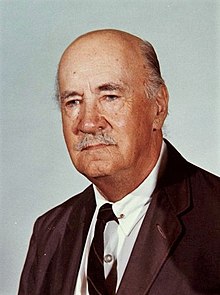 Studio portrait,c.1950 | |
| Born | Igor Ivanovich Sikorsky May 25, 1889 Kiev,Kiev Governorate,Russian Empire |
| Died | October 26, 1972(aged 83) |
| Nationality | Russian-American[1][2][3] |
| Education | |
| Occupation | Aircraft designer |
| Known for | First successful mass-producedhelicopter,theSikorsky R-4 |
| Spouses |
|
| Children | 5 |
| Awards | |
Igor Ivanovich Sikorsky(Russian:Игорь Иванович Сикорский,romanized:Igor Ivanovich Sikorsky,Ukrainian:Ігор Іванович Сікорський,romanized:Ihor Ivanovych Sikorskyi;25 May 1889 – 26 October 1972)[4]was aRussian–American[1][2][3]aviation pioneerin bothhelicoptersandfixed-wing aircraft.His first success came with theSikorsky S-2,the second aircraft of his design and construction. His fifth airplane, theS-5,won him national recognition and F.A.I. pilot's license number 64.[5]HisS-6-Areceived the highest award at the 1912 Moscow Aviation Exhibition, and in the fall of that year the aircraft won first prize for its young designer, builder and pilot in the military competition at Saint Petersburg.[6]In 1913, the Sikorsky-designedRussky Viyaz(S-21)became the first successful four-engine aircraft to take flight. He also designed and built theIlya Muromets(S-22 – S-27)family of four-engine aircraft, an airliner which he redesigned to be the world's first four-enginebomberwhenWorld War Ibroke out.
After immigrating to the United States in 1919 because of theRussian Revolution,Sikorsky founded theSikorsky Aircraft Corporationin 1923,[7]and developed the first ofPan American Airways' ocean-crossingflying boatsin the 1930s, including theSikorsky S-42"Flying Clipper".
In 1939, Sikorsky designed and flew theVought-Sikorsky VS-300,[8]the first viable American helicopter, which pioneered the rotor configuration used by most helicopters today.[9]Sikorsky modified the design into theSikorsky R-4,which became the world's first mass-produced helicopter in 1942.
Early life
Igor Sikorsky was born in Kiev,Russian Empire(nowKyiv,Ukraine) on May 25, 1889.[6][10][11]He was the youngest of five children. His father, Ivan Alexeevich Sikorsky, was a professor ofpsychologyinSaint Vladimir University(now Taras Shevchenko National University), a psychiatrist with an international reputation, and an ardentRussian nationalist.[12][13][14][15]
Igor Sikorsky was anOrthodox Christian.[16]When questioned regarding his roots, he would answer: "My family is of Russian origin. My grandfather and other ancestors from the time of Peter the Great wereRussian Orthodoxpriests. "[3]
Sikorsky's mother, Mariya Stefanovna Sikorskaya (née Temryuk-Cherkasova),[17]was a physician who did not work professionally. She is sometimes called Zinaida Sikorsky. Whilehomeschoolingyoung Igor, she gave him a great love for art, especially in the life and work ofLeonardo da Vinci,and the stories ofJules Verne.In 1900, at age 11, he accompanied his father to Germany and through conversations with his father, became interested innatural sciences.After returning home, Sikorsky began to experiment with model flying machines, and by age 12, he had made a small rubber band-powered helicopter.[18]
Sikorsky began studying at theSaint PetersburgMaritime Cadet Corps, in 1903, at the age of 14. In 1906, he determined that his future lay in engineering, so he resigned from the academy, despite his satisfactory standing, and left the Russian Empire to study in Paris. He returned to the Russian Empire in 1907, enrolling at the Mechanical College of theKyiv Polytechnic Institute.After the academic year, Sikorsky again accompanied his father to Germany in the summer of 1908, where he learned of the accomplishments of theWright brothers'FlyerandFerdinand von Zeppelin'srigid airships.[19]Sikorsky later said about this event: "Within twenty-four hours, I decided to change my life's work. I would study aviation."[20]
By the start of World War I in 1914, Sikorsky's airplane research and production business in Kyiv was flourishing, and his factory made bombers during the war. After theRussian Revolutionin 1917, Igor Sikorsky fled his homeland in early 1918, because theBolsheviksthreatened to shoot him for being "theTsar's friend and a very popular person ".[21]He moved to France where he was offered a contract for the design of a new, more powerfulMuromets-type plane. But in November 1918 the war ended, and the French government stopped subsidizing military orders, whereupon he decided to move to the United States. On March 24, 1919 he left France on the ocean linerLorrainearriving in New York City on March 30, 1919.[21][22][23][24]
Aircraft designer
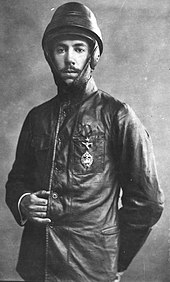
With financial backing from his sister Olga, Sikorsky returned to Paris, the center of the aviation world at the time, in 1909. Sikorsky met with aviation pioneers, to ask them questions about aircraft and flying. In May 1909, he returned to Russia and began designing his first helicopter, which he began testing in July 1909. Powered by a 25 horsepower Anzani engine, the helicopter used an upper and lower two-bladed lifting propeller that rotated in opposite directions at 160rpm.The machine could only generate about 357 pounds (162 kg) of lift, not enough to lift the approximate 457 pounds (207 kg) weight. Despite his progress in solving technical problems of control, Sikorsky realized that the aircraft would never fly. He finally disassembled the aircraft in October 1909, after he determined that he could learn nothing more from the design.[25]In February 1910, he undertook to build a second helicopter, and his first airplane. By the spring, helicopter No. 2 could lift its weight of 400 pounds (180 kg), but not the additional weight of an operator.[26]
I had learned enough to recognize that with the existing state of the art, engines, materials, and – most of all – the shortage of money and lack of experience... I would not be able to produce a successful helicopter at that time.[27]
Sikorsky's first aircraft of his own design, the S-1 used a 15 hpAnzani 3-cylinder fan enginein apusher configuration,that could not lift the aircraft. His second design called the S-2 was powered by a 25 hp Anzani engine in atractor configurationand first flew on June 3, 1910 at a height of a few feet. On June 30 after some modifications, Sikorsky reached an altitude of "sixty or eighty feet" before the S-2 stalled and was completely destroyed when it crashed in a ravine.[28][29]Later, Sikorsky built the two-seatS-5,his first design not based on other European aircraft. Flying this original aircraft, Sikorsky earned hispilot license;Fédération Aéronautique Internationale(FAI) license No. 64 issued by the Imperial Aero Club of Russia in 1911.[30]During a demonstration of the S-5, the engine quit and Sikorsky was forced to make a crash landing to avoid a wall. It was discovered that amosquitoin the gasoline had been drawn into thecarburetor,starving the engine of fuel. The close call convinced Sikorsky of the need for an aircraft that could continue flying if it lost an engine.[31]His next aircraft, the S-6 held three passengers and was selected as the winner of the Moscow aircraft exhibition held by theRussian Armyin February 1912.[30]
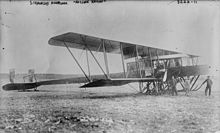
In early 1912, Igor Sikorsky became Chief Engineer of the aircraft division for theRussian Baltic Railroad Car Works(Russko-Baltiisky Vagonny ZavodorR-BVZ)[32]inSaint Petersburg.[33]His work at R-BVZ included the construction of the first four-cylinderaircraft, the S-21Russky Vityaz,which he initially calledLe Grandwhen fitted with just two engines, then theBolshoi Baltisky(The Great Baltic) when fitted with four engines in two "push-pull" pairs, and finallyRusski Vityazin its four engine alltractor-enginedconfiguration.[34]He also served as thetest pilotfor its first flight on May 13, 1913.[34]In recognition for his accomplishment, he was awarded an honorary degree in engineering fromSaint Petersburg Polytechnical Institutein 1914. Sikorsky took the experience from building the Russky Vityaz to develop the S-22Ilya Murometsairliner. Due to outbreak ofWorld War I,he redesigned it as the world's first four-enginedbomber,for which he was decorated with theOrder of St. Vladimir.
After World War I, Igor Sikorsky briefly became an engineer for the French forces in Russia, during theRussian Civil War.[35]Seeing little opportunity for himself as an aircraft designer in war-torn Europe, and particularly Russia, ravaged by theBolshevik RevolutionandRussian Civil War,he emigrated to the United States, arriving in New York on March 30, 1919.[36][37]
List of aircraft designed by Sikorsky
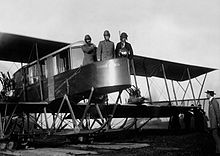
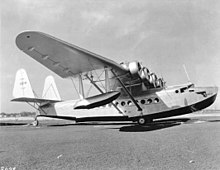
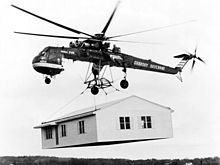
- H-1Sikorsky's first helicopter design, 1909
- H-2Sikorsky's second helicopter design, 1910
- S-1single-engine pusher biplane, Sikorsky's first fixed wing design, 1910
- S-2single-engine tractor biplane developed from the S-1, 1910
- S-3enlarged and improved version of the S-2, 1910
- S-4one-seat, single-engine biplane concept developed from the S-3, never flown, 1911
- S-5one-seat, single-engine biplane, Sikorsky's first practical aircraft, 1911
- S-6three-seat, single-engine biplane, 1912
- S-7two-seat, single-engine monoplane, 1912
- S-8two-seat single-engine biplane trainer, 1912
- S-9Kruglythree-seat, single-engine monoplane, 1913
- S-10five-seat, single-engine biplane reconnaissance/trainer developed from the S-6, 1913
- S-11Polukruglytwo-seat, single-engine mid-wing reconnaissance monoplane prototype, 1913
- S-12one-seat, single-engine trainer, Sikorsky's most successful aircraft in Russia, 1913
- S-13 and S-14proposed designs, never completed due to unavailability of engines
- S-15single-engine light bomber floatplane, 1913
- S-16two-seat, single-engine escort fighter, 1914–1915
- S-17two-seat, single-engine reconnaissance biplane based on the S-10, 1915
- S-18two-seat, twin-engine pusher biplane fighter/interceptor
- S-20two-seat biplane fighter, 1916
- S-21Russky Vityazfour-engine biplane airliner, first successful four engine aircraft, 1913
- S-22–S-27Ilya Murometsfour-engine biplane airliner and heavy bomber, 1913
- Avion Atlasproposed four-engined biplane bomber for France, cancelled due to the end of World.War I, 1918[citation needed]
- IS-27 Battleplaneproposed four-engined biplane heavy bomber, developed from the Avion Atlas, for the USAAS, 1919[citation needed]
- S-28projected four-engine biplane airliner; Sikorsky's first American design, 1919
- S-29-Atwin-engine biplane airliner, 1924
- S-34twin-engine amphibian, 1926[26]: 167, 180
- S-35trimotorbuilt forRené Fonck's attempt to win theOrteig Prize,1926[26]: 169–178
- S-36twin engine amphibian, 1927[26]: 182
- S-37twin-engine built for René Fonck, but then converted to a passenger plane, 1927[26]: 180–182
- S-38twin-engine ten-seat flying boat, 1928[26]: 182–183
- S-40four-engine amphibian built forPan Am,1931[26]: 187–193
- S-42 Clipper– flying boat, 1934
- S-43scaled-down version of S-42, 1934
- VS-300experimental prototype helicopter, 1939
- VS-44flying boat, 1942
- R-4world's first production helicopter, 1942
Life in the United States

In the U.S., Sikorsky first worked as a school teacher and a lecturer, while looking for an opportunity to work in the aviation industry. In 1932, he joined the faculty of theUniversity of Rhode Islandto form an aeronautical engineering program and remained with the university until 1948.[38]He also lectured at theUniversity of Bridgeport.
In 1923, Sikorsky formed theSikorsky Manufacturing CompanyinRoosevelt, New York.[39]He was helped by several former Russian military officers. Among Sikorsky's chief supporters was composerSergei Rachmaninoff,who introduced himself by writing a check for US$5,000 (equivalent to $89,414 in 2023).[40]Although his prototype was damaged in its first test flight, Sikorsky persuaded his reluctant backers to invest another $2,500. With the additional funds, he produced theS-29,one of the first twin-engine aircraft in the US, with a capacity for 14 passengers and a speed of 115 mph.[41]The performance of the S-29, slow compared to military aircraft of 1918, proved to be a "make or break" moment for Sikorsky's funding.[citation needed]
In 1928, Sikorsky became anaturalized citizenof the United States. The Sikorsky Manufacturing Company moved toStratford, Connecticutin 1929. It became a part of theUnited Aircraft and Transport Corporation(nowUnited Technologies Corporation) in July of that year.[42]The company manufacturedflying boats,such as theS-42"Clipper", used byPan Amfor transatlantic flights.[27]
Meanwhile, Sikorsky also continued his earlier work on vertical flight while living inNichols, Connecticut.On February 14, 1929, he filed an application to patent a "direct lift" amphibian aircraft which used compressed air to power a direct lift "propeller" and two smaller propellers for thrust.[43]On June 27, 1931, Sikorsky filed for a patent for another "direct lift aircraft", and was awarded patent No. 1,994,488 on March 19, 1935.[44]His design plans eventually culminated in the first (tethered) flight of theVought-Sikorsky VS-300on September 14, 1939, with the first free flight occurring eight months later on May 24, 1940. Sikorsky's success with the VS-300 led to theR-4,which became the world's first mass-produced helicopter, in 1942. Sikorsky's final VS-300 rotor configuration, comprising a single main rotor and a single antitorquetail rotor,has proven to be one of the most popular helicopter configurations, being used in most helicopters produced today.[9]
Personal life

Sikorsky was married to Olga Fyodorovna Simkovitch in the Russian Empire. They were divorced and Olga remained in Russia with their daughter, Tania, as Sikorsky departed after the Bolshevik Revolution in 1917. In 1923, Sikorsky's sisters immigrated to the US, bringing six-year-old Tania with them.[45]Sikorsky married Elisabeth Semion (1903–1995) in 1924, in New York.[46]Sikorsky and Elisabeth had four sons; Sergei, Nikolai, Igor Jr. and George.[47]
- Tania Sikorsky von York (March 1, 1918 – September 22, 2008), Sikorsky's eldest child and only daughter. Tania was born in Kyiv. Educated in the US, she earned a B.A. atBarnard Collegeand a doctorate atYale University.She was one of the original faculty members ofSacred Heart UniversityinBridgeport, Connecticut,where she served as Professor of Sociology for 20 years.[48]
- Sergei Sikorsky (1925– ), Sikorsky's eldest son. He joined United Technologies in 1951, and retired in 1992, as Vice-President of Special Projects atSikorsky Aircraft.[49][50]
- Igor Sikorsky Jr. is an attorney, businessman and aviation historian.[51]Igor Sikorsky III is also a pilot.[52]
Sikorsky died at his home inEaston, Connecticut,on October 26, 1972, and is buried in Saint John the Baptist Russian Orthodox Cemetery located onNichols AvenueinStratford.[53]
Legacy

In 1966, Sikorsky was inducted into theInternational Air & Space Hall of Fame.[54]
Sikorsky's andAndrei Tupolev's professional careers were covered in the 1979 Soviet biopicThe Poem of Wings(Russian:Поэма о крыльях) where Sikorsky was portrayed byYury Yakovlev.A working model ofSikorsky Ilya Murometswas recreated for filming.[55]
TheSikorsky Memorial Bridge,which carries theMerritt Parkwayacross theHousatonic Rivernext to the Sikorsky corporate headquarters, is named for him. Sikorsky has been designated a Connecticut Aviation Pioneer by the Connecticut State Legislature. The Sikorsky Aircraft Corporation in Stratford, Connecticut, continues to the present day as one of the world's leading helicopter manufacturers, and a nearby small airport has been namedSikorsky Memorial Airport.[56]
Sikorsky was inducted into the National Inventors Hall of Fame and the Junior Achievement U.S. Business Hall of Fame in 1987.[57][58]
In October 2011, one of the streets in Kyiv was renamed after Sikorsky. The decision was made by the City Council at the request of theU.S. Embassy in Ukraine,which opened its new office on that street.[59]The Sikorsky's family house in the city's historical center is preserved to this day but is in a neglected condition pending restoration.[citation needed]
In November 2012, one of the Russiansupersonicheavystrategic bomberTu-160,based at theEngels-2Air Force Base, was named for Igor Sikorsky, which caused controversy among air base crew members. One of the officers said that Igor Sikorsky does not deserve it because he laid the foundations of the U.S., rather than Russian aviation. However, theLong Range Aviationcommand officer said that Igor Sikorsky is not responsible for the activities of his military aircraft, noted that Sikorsky had also designedthe first heavy bomberfor Russia.[60]In 2013,Flyingmagazine ranked Sikorsky number 12 on its list of the 51 Heroes of Aviation.[61]
In August 2016, theNational technical university of Ukraine "Kyiv politechnical institute"was namedNational Technical University of Ukraine "Igor Sikorsky Kyiv Polytechnic Institute"its former student and outstanding aircraft designer.[62]
On March 22, 2018, theKyiv City Councilofficially renamedKyiv International Airportto "Igor Sikorsky Kyiv International Airport Zhuliany".[63][64]
Philosophical and religious views
Sikorsky was a deeply religiousRussian OrthodoxChristian[65]and authored two religious and philosophical books (The Message of the Lord's PrayerandThe Invisible Encounter). Summarizing his beliefs, in the latter he wrote:
Our concerns sink into insignificance when compared with the eternal value of human personality — a potential child of God which is destined to triumph over life, pain, and death. No one can take this sublime meaning of life away from us, and this is the one thing that matters.[66][67]
Published works
- Sikorsky, Igor Ivan.The Message of the Lord's Prayer.New York: C. Scribner's sons, 1942.OCLC2928920
- Sikorsky, Igor Ivan.The Invisible Encounter.New York: C. Scribner's Sons, 1947.OCLC1446225
- Sikorsky, Igor Ivan.The Story of the Winged-S: Late Developments and Recent Photographs of the Helicopter, an Autobiography.New York: Dodd, Mead, 1967.OCLC1396277
See also
- Aerosledge– Sikorsky built some of these propeller-poweredsnowmobilesin 1909–10
- Fedor Ivanovich Bylinkin– an early aircraft collaborator with Sikorsky, in 1910
- Sikorsky Prize– a prize for human powered helicopters named in his honor
- 10090 Sikorsky– anasteroidnamed in honor of Igor Sikorsky
References
- ^ab"Britannica Concise Encyclopedia"ArchivedApril 4, 2023, at theWayback Machine.Encyclopædia Britannica, Inc. 2006, p. 1751.
- ^ab"Sergei Sikorsky: Reflecting on the 90th Anniversary of Sikorsky Aircraft"ArchivedJuly 19, 2015, at theWayback MachineQuote: Some 90 years ago, on March 5, 1923, a Russian refugee named Igor Sikorsky organized a new company "
- ^abcJacobson, Lee (April 2013)."Igor Sikorsky Was a Reflection of His Heritage and Experiences in Life"(PDF).Sikorsky Archives News.Igor I. Sikorsky Historical Archives.Archived(PDF)from the original on January 21, 2022.RetrievedMay 25,2020.
My family is of Russian origin. My grandfather and other ancestors from the time of Peter the Great were Russian Orthodox priests. Consequently, the Russian nationality of the family must be considered as well established
- ^Fortier, Rénald."Igor Sikorsky: One Man, Three Careers."ArchivedOctober 16, 2013, at theWayback Machineaviation.technomuses.ca,1996. Retrieved: October 29, 2008.
- ^"Sikorsky Archives | S-5".SikorskyArchives.Archivedfrom the original on July 18, 2018.RetrievedJuly 28,2018.
- ^ab"History".SikorskyArchives.Part 2.Archivedfrom the original on August 8, 2020.RetrievedApril 27,2020.
- ^"About Sikorsky."ArchivedNovember 3, 2009, at theWayback MachineSikorsky Aircraft.Retrieved: December 11, 2008.
- ^Spenser 1998, p. 25.
- ^abWoods 1979, p. 262.
- ^"Igor Sikorsky | Historical Archives | History"ArchivedJune 1, 2019, at theWayback Machine.sikorskyarchives
- ^Sergei I. Sikorsky (2007).The Sikorsky Legacy.Arcadia Publishing. p. 7.ISBN9780738549958.
- ^Homo Imperii A History of Physical Anthropology in Russia,Marina Mogilner 2013, p. 72.
- ^Homo Imperii A History of Physical Anthropology in Russia,Marina Mogilner 2013, p. 167.
- ^Homo Imperii A History of Physical Anthropology in Russia,Marina Mogilner 2013, p. 177.
- ^Hillis, Faith.Children of Rus': Right-Bank Ukraine and the Invention of a Russian Nation 2013,ISBN0801452198,p. 259.
- ^"Sikorskyarchives".Archivedfrom the original on January 18, 2015.RetrievedJanuary 18,2015.
- ^Mikheev, V. R."Sikorsky: Hero, Exile, the Father of Aviation" (English translation).ArchivedDecember 9, 2015, at theWayback MachinePravmir.ru,October 31, 2011. Retrieved: May 16, 2012.
- ^Woods 1979, p. 254.
- ^"The Case Files: Igor Sikorsky"ArchivedAugust 25, 2017, at theWayback Machine.Franklin Institute.Retrieved: August 24, 2017.
- ^Christiano, Marilyn (July 5, 2005)."Igor Sikorsky: Aircraft and Helicopter Designer".Voice of America News.Archived fromthe originalon August 3, 2008.RetrievedJuly 17,2010.
- ^ab[1]ArchivedDecember 6, 2012, at theWayback Machine"Sergei Sikorsky: My father's fate (English translation version of an interview published in Russian by pravmir.ru)"
- ^"Игорь Иванович Сикорский: отец авиации и храмостроитель".Pravmir(in Russian). June 7, 2009.Archivedfrom the original on August 15, 2016.RetrievedJune 28,2016.
- ^Kutuzov, Mikhail."The Genius of Flight" (English translation).ArchivedOctober 18, 2015, at theWayback MachineRussian Archipelago,2012. Retrieved: May 16, 2012.
- ^Ukrainian Congress Committee of America 1978,p. 187
- ^Woods 1979, p. 255.
- ^abcdefgSikorsky, Igor (1952).The Story of the Winged-S.New York: Dodd, Mead & Company. pp. 25–37.
- ^ab"Igor Sikorsky."ArchivedMarch 5, 2010, at theWayback MachineEncyclopædia Britannica, 2009viabritannica.Retrieved: October 14, 2009.
- ^Sikorsky, Igor (1944).The Story of the Winged-S.New York: Dodd, Mead & Company. p. 48.ISBN9781258163556.
- ^"Sikorsky Celebrates."Popular AviationSeptember 1930, p. 20.
- ^abWoods 1979, p. 256.
- ^Current Biography 1940,pp. 734–736.
- ^Murphy 2005, p. 180.
- ^Lake 2002, p. 31.
- ^abHaddrick Taylor, Michael John (May 1, 1986).The Illustrated Encyclopedia of Helicopters.Exeter Books. p. 34.ISBN9780671071493.
- ^"Airmen leave Russia."ArchivedJanuary 21, 2022, at theWayback MachineThe New York Times,June 25, 1918. Retrieved May 23, 2011.
- ^Woods 1979, p. 257.
- ^"Russian airplane will be made here."ArchivedJanuary 21, 2022, at theWayback MachineThe New York Times,April 20, 1919. Retrieved: July 17, 2010.
- ^"URI History and Timeline".University of Rhode Island. Archived fromthe originalon November 14, 2012.RetrievedJuly 17,2010.
- ^Spenser 1998, p. 15.
- ^Prokhorov, Vadim."Oldies & Oddities: Sikorsky's Piano Man" (History of Flight).ArchivedJuly 24, 2012, atarchive.todayAir & Space Magazine/Smithsonian,Volume 17, Issue 4, November 1, 2002. Retrieved: July 17, 2010.
- ^Current Biography 1940,p. 735.
- ^Spenser 1998, pp. 15–17.
- ^"Patent number: 1848389".Google.Archived fromthe originalon February 17, 2013.RetrievedNovember 25,2010.
- ^"Patent number: 1994488."ArchivedFebruary 17, 2013, at theWayback Machinegoogle.Retrieved: November 25, 2010.
- ^"Military Mission."ArchivedSeptember 6, 2008, at theWayback MachineThe Case Files: Igor Sikorsky,Franklin Institute.Retrieved: October 29, 2008.
- ^Hacker and Vining 2007, p. 116.
- ^SkywaysJuly 1995, p. 71.
- ^"Tania Sikorsky Von York."ArchivedMarch 3, 2016, at theWayback MachineFoster's Daily Democrat,September 26, 2008. Retrieved: October 16, 2008.
- ^"First Helicopter Civilian Rescue November 29, 1945."ArchivedDecember 10, 2008, at theWayback MachineSikorskyarchives.Retrieved: July 17, 2010.
- ^Zenobia, Keith."Sergei Sikorsky: Recollections of a Pioneer, The Legacy of Igor Sikorsky."ArchivedAugust 1, 2020, at theWayback MachinePMLAA News Newsletter (Pine Mountain Lake Aviation Association),19:6, 2004. Retrieved: December 2, 2010.
- ^Church, Diane."Sikorsky to speak in Plainville tonight."Bristol Press,March 19, 2012.
- ^"Igor Sikorsky Seminar."ArchivedMarch 4, 2014, at theWayback MachineAviation Digest: Bradford Camps,June 2003.
- ^""St. John the Baptist Russian Orthodox Cemetery"".Archivedfrom the original on January 16, 2015.RetrievedJanuary 16,2015.
- ^Sprekelmeyer, Linda, editor.These We Honor: The International Aerospace Hall of Fame.Donning Co. Publishers, 2006.ISBN978-1-57864-397-4.
- ^Сушинова, Яна (May 28, 2018)."Самолет С-22" Илья Муромец ". Инфографика"."Аргументы и факты".Archivedfrom the original on November 4, 2018.RetrievedNovember 3,2018.
- ^"Igor I. Sikorsky: Sikorsky Aircraft."ArchivedJanuary 9, 2013, at theWayback MachineJA Worldwide.Retrieved: October 12, 2009.
- ^Ikenson 2004, p. 24.
- ^"Igor I. Sikorsky."ArchivedDecember 11, 2009, at theWayback MachineNational Inventors Hall of Fame Foundation, Inc.viainvent.org.Retrieved: October 12, 2009.
- ^"Kyiv changes street name at Washington's request"ArchivedNovember 22, 2011, at theWayback MachineKyiv Post.Retrieved: November 26, 2011.
- ^Mikhailov, Alexei and Bal′burov, Dmitry."Ту-160 присвоили имя американского авиаконструктора Сикорского (in Russian) (The Tu-160 was named after the American Sikorsky Aircraft Designer)."ArchivedDecember 22, 2014, at theWayback MachineIzvestiaNovember 13, 2012.
- ^"Flyingmag".Archivedfrom the original on October 31, 2020.RetrievedSeptember 26,2014.
- ^"The history of KPI | Igor Sikorsky Kyiv Polytechnic Institute".Archivedfrom the original on April 18, 2020.RetrievedFebruary 2,2020.
- ^[2]ArchivedMarch 23, 2018, at theWayback Machine.Pravda
- ^"Kyiv Zhuliany Airport (IEV)".Archivedfrom the original on February 13, 2020.RetrievedNovember 22,2019.
- ^"Faith Of the Orthodox Born in Russia".The New York Times.Archivedfrom the original on December 26, 2021.RetrievedFebruary 16,2017.
- ^"The Invisible Encounter".ArchivedApril 4, 2023, at theWayback MachineThe Universalist Leader,Volume 130, Issue 5, 1948, p. 115.
- ^"Igor I. Sikorsky."ArchivedJuly 7, 2011, at theWayback MachineAvStop Online Magazine.Retrieved: July 17, 2010.
Sources
- Delear, Frank J.Igor Sikorsky: His Three Careers in Aviation.New York: Dodd Mead, 1969, Revised edition, 1976.ISBN978-0-396-07282-9.
- Hacker, Barton C. and Margaret Vining.American Military Technology: The Life Story of a Technology.Baltimore, Maryland: Johns Hopkins University Press, 2007.ISBN978-0-8018-8772-7.
- Ikenson, Ben.Patents: Ingenious Inventions, How They Work and How They Came to Be.New York: Black Dog & Leventhal Publishers, 2004.ISBN978-1-57912-367-3.
- Lake, Jon.The Great Book of Bombers: The World's Most Important Bombers from World War I to the Present Day.St. Paul, Minnesota: MBI Publishing Company, 2002.ISBN0-7603-1347-4.
- Leishman, J. Gordon."The Dream of True Flight."Online summary:Principles of Helicopter Aerodynamics.Cambridge, UK: Cambridge University Press, 2006.ISBN0-521-85860-7.
- Murphy, Justin D.Military Aircraft, Origins to 1918: An Illustrated History of Their Impact(Weapons and warfare series). Santa Barbara, California, USA: ABC-CLIO, 2005.ISBN1-85109-488-1.
- Sikorsky, Igor Ivan.The Story of the Winged-S: Late Developments and Recent Photographs of the Helicopter, an Autobiography.New York: Dodd, Mead, originally published 1938 (updated editions, various years up to 1948), Revised edition, 1967.
- Spenser, Jay P.Whirlybirds, A History of the U.S. Helicopter Pioneers.Seattle, Washington, USA: University of Washington Press, 1998.ISBN0-295-97699-3.
- Woods, Carlos C."Memorial Tributes", pp. 253–266.Igor Ivan Sikorsky.Washington, D.C.: National Academy of Engineering (The Academy), 1979.
- Ukrainian Congress Committee of America(1978). "Sikorsky".The Ukrainian Quarterly.34–35 (1).ISSN0041-6010.
- U.S. patent 2,318,259
- U.S. patent 2,318,260
External links
- Official Sikorsky historical archives
- Igor SikorskyatIMDb
- Igor SikorskyAerial Russia – the Romance of the Giant Aeroplane – early days of Igor Sikorsky online book
- Igor Sikorsky article on ctheritage.org
- Igor Sikorsky.Time magazine, November 16, 1953. (Cover)
- The New England Air MuseumArchivedNovember 16, 2017, at theWayback Machinein Windsor Locks, Connecticut, has extensive Sikorsky exhibits
- Wingless Helicopter Flies Straight UpSeptember 1940Popular Mechanicsarticle showing Sikorsky flying his first helicopter and introducing him to the general public
- 1889 births
- 1972 deaths
- Aircraft designers
- American aerospace engineers
- American inventors
- American people of Russian descent
- ASME Medal recipients
- Aviation history of Russia
- Aviation history of the United States
- Aviation inventors
- Aviation pioneers
- Businesspeople in aviation
- Emigrants from the Russian Empire to France
- Emigrants from the Russian Empire to the United States
- Kyiv Polytechnic Institute alumni
- Members of the Early Birds of Aviation
- National Medal of Science laureates
- People from Easton, Connecticut
- Engineers from Kyiv
- Recipients of the Order of St. Vladimir
- Russian aerospace engineers
- Russian inventors
- Russian Orthodox Christians from the United States
- University of Bridgeport faculty
- University of Rhode Island faculty
- 20th-century Russian engineers
- 20th-century American engineers
- 20th-century Russian businesspeople
- Businesspeople from the Russian Empire
- 20th-century American businesspeople
- Russian scientists
